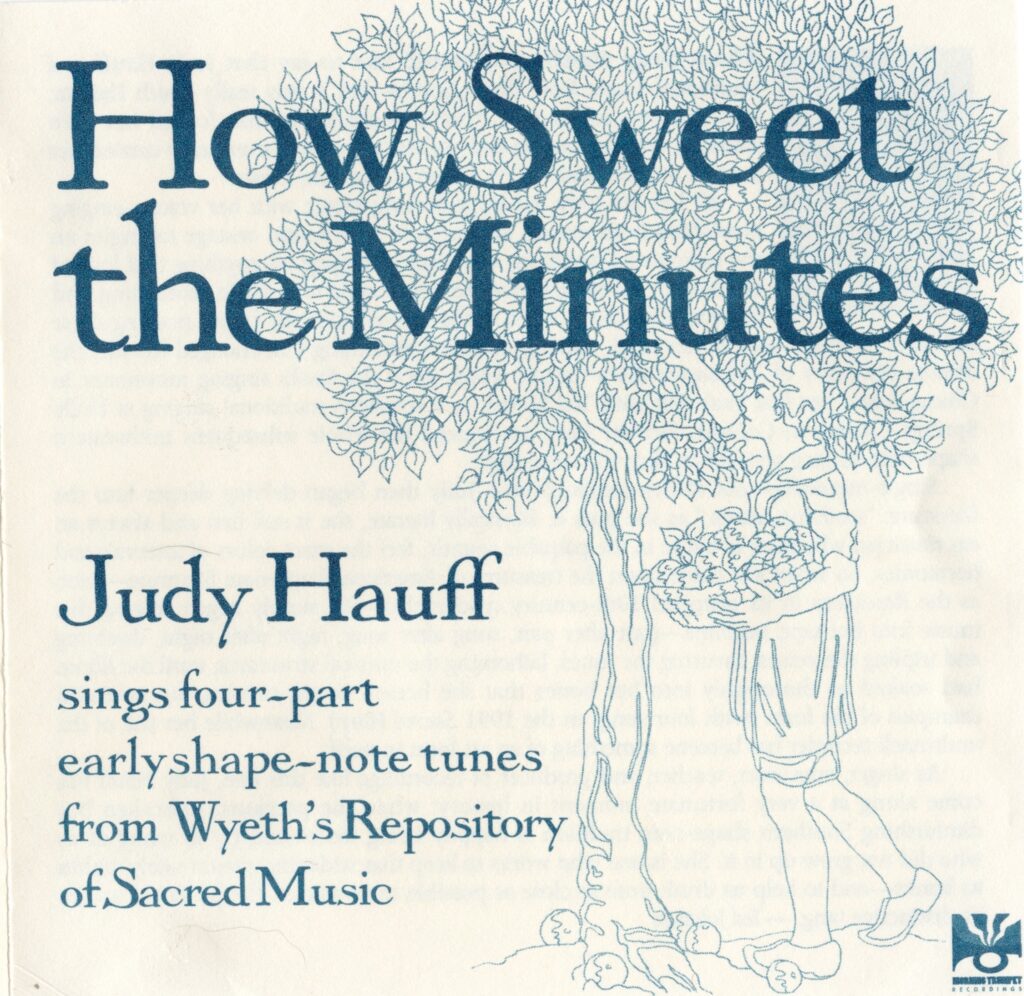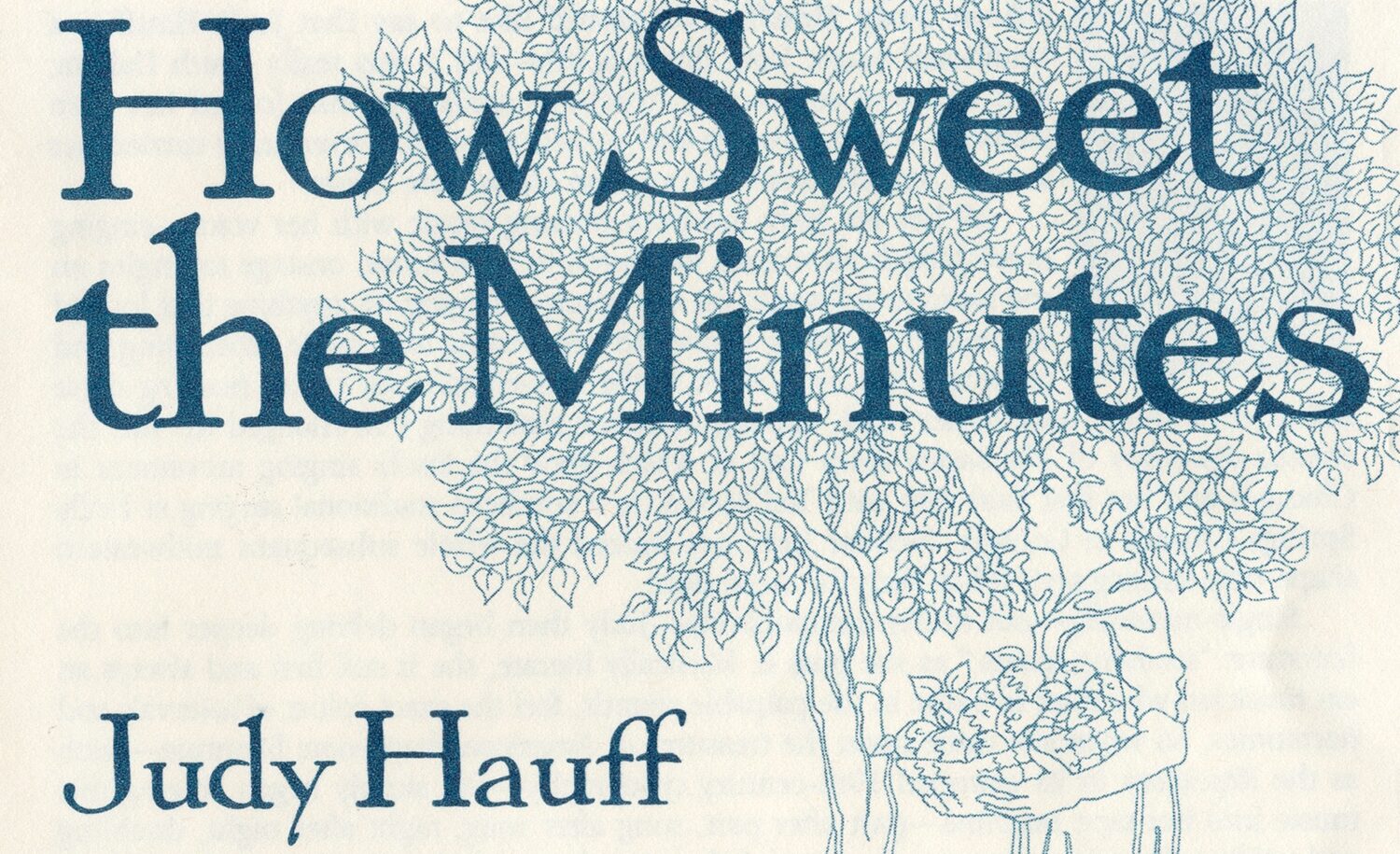Judy Hauff’s How Sweet the Minutes, a 1996 recording of 42 shape-note tunes from Wyeth’s Repository of Sacred Music, is now available for streaming and download on Bandcamp. Originally recorded in 1985 as a personal project to explore Sacred Harp singing, the tapes were later discovered and edited for release. Hauff performs all four vocal parts using multitrack recording, offering a subdued and peaceful interpretation of these early American hymns. The cover illustration is by Melanie Hauff and CD liner was designed by Lisa Grayson.




“About this recording…found in a paper bag in a closet…Judy Hauff, using a multitrack recorder, is singing all parts, and singing each part more than once. And just as Judy is singing early shape-note music, this recording is early Judy Hauff. We think she recorded it in July, 1985, just two months after the first Illinois State Singing Convention in Paxton, Illinois–the first all-day singing in the Midwest and the first voice-to-voice meeting of midwestern and southern singers. We Chicagoans were captivated – actually, completely blown away – by the traditional sound of the music. But we weren’t yet familiar with Sacred Harp singing practices. We led from a raised platform in the center of the square; Judy herself even took a music stand with her when it was her turn to lead! If you’re wondering, then, why Judy is not singing the names of the notes (fa,sol, la, mi) on a shape-note recording, it’s because the shapes were too new to her. This recording was never intended to be heard beyond a small circle of Judy’s friends. While cleaning out a closet in 1995, I found the tape in a grocery bag; it had been used by the Chicago Sacred Harp Singers in selecting tunes for A Midwest Supplement (1987), which went through numerous printings totaling just under a thousand copies, and where Judy’s “Wood Street” and “Granville” (both in the 1991 Sacred Harp) first appeared.
A brief word about Wyeth’s Repository of Sacred Music: Actually, there are two tune books, one with the above title and one with ‘Part Second’ appended. The former was first published in 1810; the latter, 1813. John Wyeth was an editor-printer and bookseller without any special interest in music – but with an ear for what would sell. The Repository sold 120,000 copies, an astonishing number for that time. The first book (“Part 1″on this recording) tends to have more “composed” tunes in four parts; the second (‘Part 2’), more folk melodies in two or three parts. Some tunes such as ‘Wickham’ exemplify the early-19th-century musical struggle in the north, which ended with a crushing victory for the all-too-self-conscious advocates of European practices, who were ashamed of the “crude” home-grown product. [For more information about Wyeth’s Repository, see D.W. Steel, “John Wyeth and the Development of Southern Folk Hymnody; Music from the Middle Ages through the 20th Century: Essays in Honor of Gwynn McPeek (London: Gordon & Breach, 1988).]” –Theodore Mercer
“About Judy Hauff: One would like to say that Judy Hauff is a traditional singer from down South—but it was really South Dakota; and like any self-taught, true born artist, she has forged her own tradition—an instinctive and authentic one that eventually carried her straight into the heart of American shape-note music.
All her life Judy has been making music with her voice-singing everything from masses in church to rock music onstage to jingles on the radio to folksongs on the porch-digging up anything that looked interesting, turning it over to see how it was made, absorbing and making it her own. Then in the mid-eighties she began pushing these influences into the back of her head, making room for something that changed her life: the chance discovery of The Sacred Harp (out of which grew the fasola singing movement in Chicago) and her first fatal visit with Ted Mercer to a southern traditional singing at Holly Springs Church in Georgia. Neither Judy nor indeed the whole subsequent midwestern shape-note singing revival has been the same since.
Single-mindedly – not to say compulsively – Judy then began delving deeper into the literature: “studying scores,” as she puts it. Musically literate, she is still first and always an ear musician who likes to bathe in the palpable sounds, feel the exact colors of intervals and harmonies. So when she came upon the treasures of American shape-note literature-such as the Repository in its cramped 19th-century typography-she simply began singing this music into her tape machine—part after part, song after song, night after night, doubling and tripling the voices, savoring the tunes, fathoming the musical structures, until the idiom had soaked so thoroughly into her bones that she herself began turning out splendid examples of the form (with four songs in the 1991 Sacred Harp). Meanwhile her use of the multitrack recorder has become something of an art form in itself.
As singer, composer, teacher, and producer of recordings like this one, Judy Hauff has come along at a very fortunate moment in history: when the precious, unbroken but diminishing Southern shape-note tradition is happily being discovered by so many of us who did not grow up in it. She is one who works to keep that widening stream safely within its banks and to help us drink from as close as possible to its source, the better to capture its distinctive tang.” – Ted Johnson


Leave a Reply